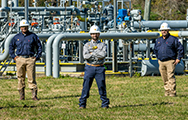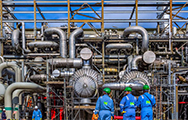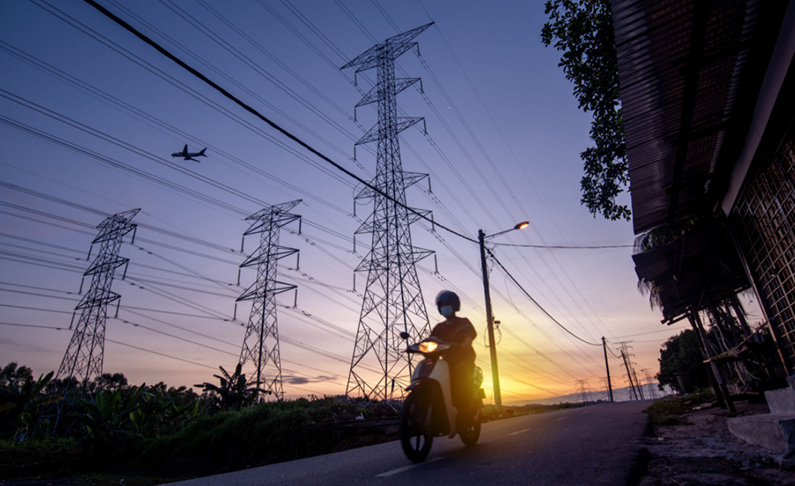Performance highlights
This table represents a selection of global metrics that we track within Shell. These metrics have been selected because they reflect the direct impact of Shell companies’ operations on people and the environment. We used them to set our goals and measure progress in 2020 and to define priorities for 2021.
We review our metrics regularly to ensure we capture the information needed to improve our performance. We introduced Goal Zero for personal safety at Shell in 2007. Since then, we have broadened the goal to aim for no harm to people and the environment. More information on our performance, definitions of the indicators and the referenced goals is provided in the environmental, social and safety data sections.
Goals, performance and plans
Personal safety
Personal safety
Goal 2020
TRCF ≤ 0.8
Achieve total recordable case frequency (TRCF) – the number of injuries per million working hours – of 0.8 or below for employees and contractors.
Goal Zero has been our ambition for personal safety since 2007.
Progress in 2020
Total recordable case frequency (TRCF)
The TRCF was 0.7 in 2020 compared with 0.9 in 2019 (see Safety performance).
Priorities in 2021
- Continue deploying our refreshed approach to safety, with a more consistent focus on the way people, culture, equipment, work systems and processes interact.
- Move from using our 12 Life-Saving Rules to the simplified set of nine Life-Saving Rules of the International Association of Oil & Gas Producers (IOGP).
- In road safety, continue to focus on effectively implementing proven practices across all our businesses, with an emphasis on improving the management of fuel transport in high-risk countries. Work with road transport contractors to increase the use of advanced technology to support safe driving.
- Improve our capabilities to learn from audit findings and investigations into incidents which have the potential to cause harm.
Process safety
Process safety
Goal 2020
Leaks ≤ 115
Reduce the number of operational leaks to 115 or below (classified as “operational Tier 1 and 2 process safety events”).
Since 2011, we have extended our ambition of Goal Zero to process safety. From 2017, we combined operational Tier 1 and 2 safety events when setting the target. Previously, we only used Tier 1 events.
Progress in 2020
Number of operational process safety Tier 1 and 2 events
The number of Tier 1 and 2 operational process safety events decreased from 130 in 2019 to 103 in 2020 (see Safety performance).
Priorities in 2021
- Continue to focus on asset integrity and quality of operational execution by, among other things, shifting attention to leading indicators to understand and measure success, embedding our Process Safety Fundamentals, and rolling out a group-wide asset management system.
- Continue to improve learning from process safety events with high potential impact.
GHG and Energy
GHG and Energy
Goal 2020
Reduce the carbon intensity of the energy products we sell, in step with society
We have a short-term target to reduce our Net Carbon Footprint by 2-3% by 2021, compared with 2016.
This target is measured using the Net Carbon Footprint metric and methodology. For more on how we calculate our Net Carbon Footprint visit www.shell.com/ncf
Progress in 2020
Net Carbon Footprint: g CO2e/MJ
Shell’s Net Carbon Footprint in 2020 was 75 grams of CO2 equivalent per megajoule, a 4% reduction from the previous year and a 5% reduction from the 2016 reference year.
Priorities in 2021
- Continue taking steps to cut greenhouse gas (GHG) emissions from our existing oil and gas operations, and to avoid generating more in the future.
- Increase the proportion of lower-carbon products such as natural gas, biofuels, electricity and hydrogen in the mix of products we sell.
- Work with our customers to help them address the GHG emissions they produce when they use products sold by us.
GHG and Energy
Goal 2020
Reduce flaring in our Upstream business.
Our policy is to reduce flaring and venting to as low a level as reasonably practicable.
We are a signatory of the World Bank’s Zero Routine Flaring by 2030 initiative.
Progress in 2020
Upstream flaring: million tonnes CO2 equivalent [A]
[A] Includes Upstream and Integrated Gas
Our upstream flaring decreased to 3.8 million tonnes of CO2 equivalent in 2020 from 5.9 million tonnes in 2019 (see Flaring).
Priorities in 2021
- Continue to link staff bonuses to the management of greenhouse gas emissions.
- Further embed the guiding principles for reducing methane emissions across the natural gas value chain, which Shell and seven other energy companies signed in November 2017.
- Continue to focus on maintenance measures to enhance the reliability of our equipment and reduce emissions through leaks.
GHG and Energy
Goal 2020
Upstream and Integrated Gas GHG intensity ≤ 0.162
For our Upstream and Integrated Gas facilities, achieve a GHG intensity of 0.162 tonnes or below of CO2 equivalent per tonne of hydrocarbon production available for sale.
Progress in 2020
Upstream and Integrated Gas: tonnes CO2e per tonne of hydrocarbon production available for sale
Our Upstream and Integrated Gas GHG intensity was 0.159 tonnes CO2 equivalent per tonne of hydrocarbon production available for sale in 2020 compared with 0.168 in 2019.
Priorities in 2021
GHG & Energy
Goal 2020
Refinery GHG intensity ≤ 1.02
For our refineries, reduce GHG intensity to 1.02 tonnes or below of CO2 equivalent per Solomon’s Utilised Equivalent Distillation Capacity (UEDC)
Progress in 2020
Refineries: tonnes CO2e per Solomon’s UEDC
Refinery GHG intensity in 2020 was 1.05 tonnes CO2e per UEDC compared with 1.06 in 2019.
Priorities in 2021
- Continue to link staff bonuses to the management of greenhouse gas emissions.
- Continue to focus on maintenance measures to enhance the reliability of our equipment and reduce emissions through leaks.
GHG & Energy
Goal 2020
Chemicals GHG intensity ≤ 0.96
For our chemical plants, reduce GHG intensity to 0.96 tonnes or below of CO2 equivalent per tonne of high-value petrochemicals produced.
Progress in 2020
Chemicals: tonnes CO2e per tonne of petrochemicals produced
Chemical GHG intensity was 0.98 tonnes CO2 equivalent per tonne of high-value chemicals produced in 2020 compared with 1.04 in 2019.
Priorities in 2021
Environment
Environment
Goal 2020
Goal Zero extends to the environment with our goal of no operational spills.
Progress in 2020
Volume of operational spills in thousand tonnes
There were 69 operational hydrocarbon spills in 2020 compared with 67 in 2019. The volume of operational spills of oil and oil products in 2020 was 0.4 thousand tonnes, an increase from 0.2 thousand tonnes in 2019 (see Environmental performance).
Priorities in 2021
- Continue to learn from incidents with spills to improve the reliability of our facilities and further reduce the number and volume of operational spills.
- Continue to work with the oil and gas industry to further develop effective oil-spill response capacities.
Social performance
Social performance
Goal 2020
Effective community feedback
- Introduce our new online community feedback tool to help us manage the reporting and tracking of feedback more efficiently.
- Implement action plans related to community feedback mechanisms (CFM) at priority sites, to enable a proactive approach to managing feedback.
Progress in 2020
- The roll-out of our new community feedback tool enabled a 66% increase in reported feedback. We received a wide range of comments, including complaints, questions, requests and positive feedback.
- We supported the implementation of CFM improvement plans at 14 sites. This was based on an assessment informed by the UN Guiding Principles for Business and Human Rights.
- We also developed a guide to help sites to make their CFMs effective and to address the needs of local communities.
Priorities in 2021
- Train new staff with community-facing roles to implement effective CFMs.
- Continue to support the implementation of CFM improvement plans of priority sites.




